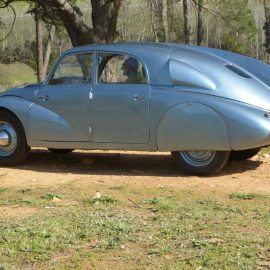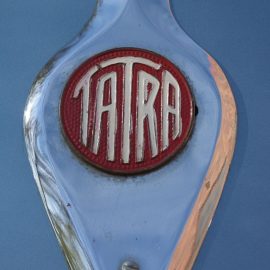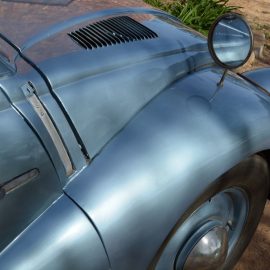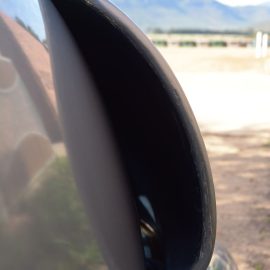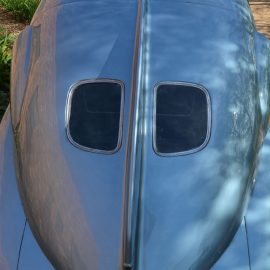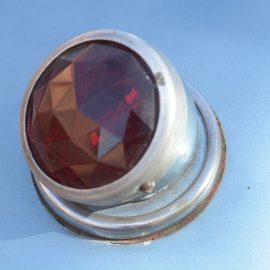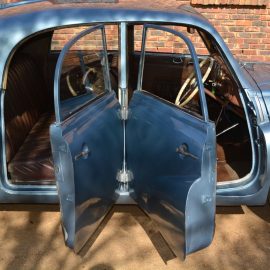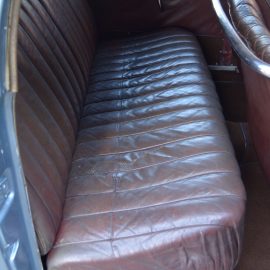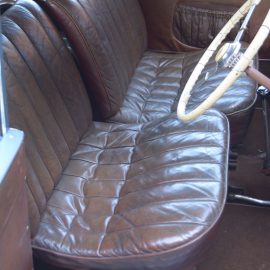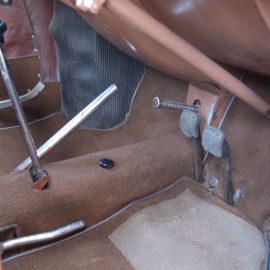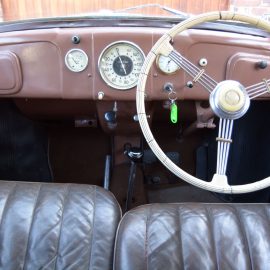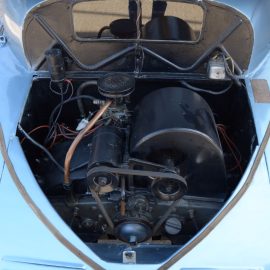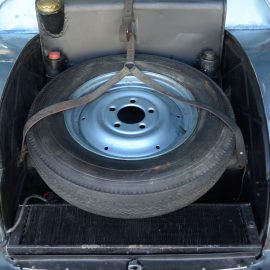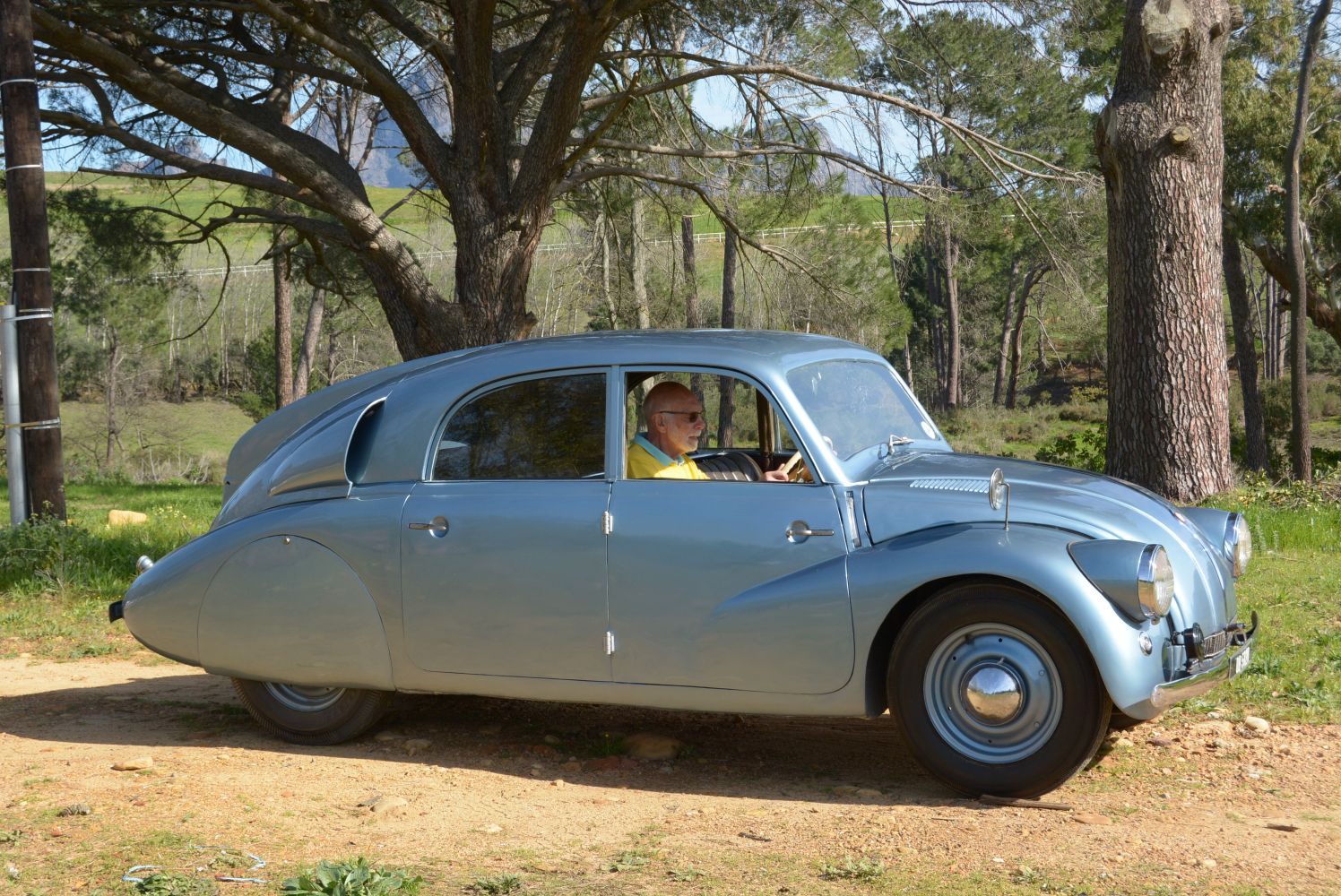
30 Jun Collection In Action: Tatra T97
It is perhaps hard to believe that in the 1930s, one of the auto world’s more innovative manufacturers was situated behind the Iron Curtain, in Czechoslovakia. Mike Monk drives an aerodynamic example that was said to have brought about the Beetle…
Tatra is one of the automotive world’s less-recognised manufacturers, yet its origins go back to 1850, making it the third oldest company with an unbroken history still making vehicles. Founded as Schustala & Company and later renamed Nesselsdorfer Wagenbau-Fabriksgesellschaft, the company produced the first motor car in central Europe in 1897. The vehicles were built in a factory in Nesselsdorfer and the name Tatra, which stemmed from the Tatra Mountains on what was then the Polish-Czechoslovak border, was adopted in 1919. Prior to the outbreak of WWII, Tatra was producing some radical machines led by a talented Austrian designer named Hans Ledwinka.
Not least of these was a series of aerodynamic, rear-engined cars simply titled T77, T77a and T87, the styling of which was done in consultation with Paul Jaray, who had worked at Luftschiffbau Zeppelin (LZ). Jaray gained experience with the aerodynamic design of airships and he used LZ’s wind tunnels to establish the streamlining principles for car design. In 1927 he founded a company specialising in developing streamlined car bodies but Tatra was the only manufacturer to make use of his expertise (under licence) for a production car.
In 1936 Tatra decided to introduce an ‘entry level’ T-series model. Under the guidance of Hans, the T97 was created by Erich Ledwinka, one of Hans’ sons, and a German design engineer Erich Überlacker. It was a scaled down version of the V8-engined T-series cars and almost identical in style. The most obvious differences between the T97 and its predecessors were the lack of the sixth window on each side, the adoption of a one-piece windscreen, the omission of the third headlamp and the fitment of a four-cylinder flat-four engine. It was around this time that Ferdinand Porsche was busy working on a KdF-Wagen prototype for Volkswagen, of which more anon…
Part of FMM’s collection is a 1938 T97 that was previously part of the famous Greyvensteyn collection based in the Free State, and although its light metallic blue paintwork is not original, the colour actually suits the car. It was partially renovated some years ago and is now showing a few signs of wear and tear that, as is often the case, actually adds some charm to its character. Considering that this example is 84 years old, it can be forgiven a few blemishes as its looks certainly are attractive – and dare I say dramatic even? A ridge emanating from just above the sloping windscreen runs back over the roof to become a ‘shark fin’ tail that splits the rear window. The T97 has an impressive drag coefficient of just 0,36, making it one of the most aerodynamic cars of its time, despite the bulging ‘frog eye’ headlamps. Full rear wheelarch spats help smooth the air flow past the car.
Front and rear doors are hinged on the B-pillar, and have stylish, flush-fitting handles. Although trimmed in pleated leather, the front seat design is what can best be described as utilitarian. To be fair, they are wide and surprisingly comfortable despite the less-than-generous padding, and the backrest carries a full-width grab rail for rear seat passengers. The door panels contain elasticated pockets and at either end of the metal dashboard there are small, lidded gloveboxes. The speedo and fuel gauge are supplemented with a non-original clock. The cream-coloured Bakelite steering wheel rim has, inevitably, cracked with time but the wire-spring spokes help evoke period charm.
The view out front and to the side is excellent thanks to the deep glasshouse but to the rear vision is limited through a small vertical, rectangular window in the bulkhead immediately behind the rear seat. This, in turn, allows sighting through the split rear window in the massive, one-piece, top-hinged engine cover – it is a bit like looking backwards through a telescope. The front fender-mounted mirror is a welcome aid to knowing what is going on behind.
The ignition key is an odd, dimpled item that has to be turned and pushed in to activate the electrics. To start the car, pull up on a lever mounted down alongside the floor tunnel – a cable runs backwards to the starter motor. And it starts instantly. The floor-mounted pedals are offset to the left – the brake and clutch paired fairly close together – and the car pulls away with ease. The gearbox is a four-speed with a fairly close gate, and reverse plane selected by pulling up on the flat-topped gear knob.
Powering the T97 is an air-cooled 1749cc boxer motor producing 30 kW at 3 500 r/min. A narrow intake just above the bumper feeds air to the front-mounted oil cooler while ear-like scoops on the C-pillars force air into the engine bay. Torque figures are unavailable but its inherent lack of grunt is easy to overcome with sensible use of the gearbox. With a kerb weight of 1 150 kg, the T97 is surprisingly light considering how heavy the front and rear hoods are, but the T97 was claimed to sprint from 0-100 km/h in 44,2 seconds and reach a top speed of 130 km/h. Thanks to its aerodynamics and gearing, it was capable of cruising all day at 110 km/h without fuss.
The 4 270 mm-long T97 is built on a pressed steel platform with a central tube for added strength. It boasts independent suspension all round and with a 2 600 mm wheelbase, the ride is remarkably smooth and relaxing. Rack and pinion steering offers good control and feedback and hydraulic drum brakes provide good stopping ability. Whether on tar or gravel, the T97 is one of those cars that the more you drive it the more impressed you become with its simple, fuss-free nature.
If a lot of this story so far makes you think of what a Volkswagen Beetle was all about, then you will not be too surprised to learn that there was a lawsuit over their similarities. Elements of both the design and technical specifications of the T97 have a strong resemblance to VW’s KdF-Wagen, which became known as the Beetle. The story goes that Hitler had ridden in Tatras during political tours of Czechoslovakia, and had even dined with Ledwinka on numerous occasions. In the wake of one of these dinners, Hitler remarked to Ferdinand Porsche, “This is the car for my roads”. From 1933 onwards, Ledwinka and Porsche met regularly to discuss the concept, and being under pressure to produce a ‘car for the people’ quickly, Porsche reportedly did admit to having ‘looked over Ledwinka’s shoulders’ while designing the Volkswagen.
Tatra sued Porsche for damages and Porsche was willing to settle, but the agreement was cancelled by Hitler after Czechoslovakia was invaded by the Nazis. Production of the T97 was immediately halted and the lawsuit dropped. However, after the war the lawsuit was reopened and in 1965 the matter was settled when VW paid Tatra what is said to have been one million Deutsche Mark in compensation.
The T97 was built between 1936 and 1939 and only 508 were manufactured. In 1945,Tatra was nationalised and production of the pre-war models resumed, but the T97 was soon dropped in favour of the larger and more modern T600 Tatraplan. Today, the company is known more for its truck operation – Tatras are always well represented on the gruelling annual Dakar Rally, having won the truck category on a number of occasions. But its Ledwinka-led designs that appeared in the 1930s represented some of automotive history’s more fascinating developments – and not a little notoriety in the process. The Beetle may have conquered the world, but Tatra helped sow the seed of success.
FMM’s Tatra T97 is currently on view in Hall A.




